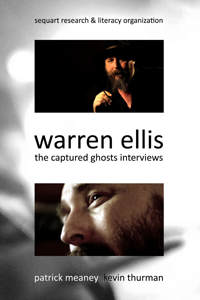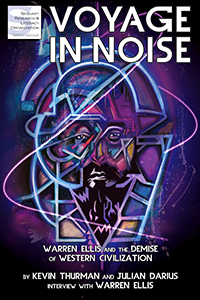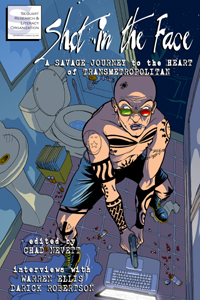In How To Read Superhero Comics and Why, Klock applies Harold Bloom’s concept of the ‘agon’ to Ellis’s treatment of superheroes in his work for WildStorm. For Bloom, poets can only escape the ‘anxiety of influence’ by convincing themselves that they have to improve upon the work of their predecessors. Therefore, young poets write in opposition to those who have come before. Klock identifies the battle between analogues of pulp characters and DC’s super-team the Justice League of America in the first issue of Planetary as representative of Ellis’s combative approach to the superhero genre. Klock also locates the agon in issue 7 (January, 2000) when a Constantine analogue, Jack Carter, described by Wagner as ‘everything you wanted London to be’, kills a Marvelman-esque superhero who is, as Klock writes, ‘angry that he has been sullied by the kind of things with which [Vertigo] would sully a superhero: paedophilia, split-personalities, nervous breakdowns’ (16). However, Ellis also has Snow describe the analogues of Vertigo characters who appear in the issue as ‘faintly ridiculous’. Jakita partially concurs but qualifies her agreement, stating: “The important thing is how they dealt with the time. And it was not the best of times.”
As Klock observes, Ellis draws our attention to ‘the hidden road that connects socioeconomic depravity’ of the kind experienced by the British working class under the Thatcher administration in the ‘80s, to ‘the resurgence of horror and the critique of the clean, noble, perfect superhero’ as exemplified by Vertigo during the decade and into the ‘90s (160). The message communicated via Carter, functioning as another avatar for Ellis, is that the ‘80s Vertigo style has itself become stagnant, the influence of Moore’s run on Swamp Thing — which, although not published by the imprint, was the template for its aesthetic — prohibitive. After killing the Marvelman analogue, Carter reveals his tattooed torso, similar in design to Ellis’s character / avatar in his Vertigo series Transmetropolitan, Spider Jerusalem (a Hunter S Thompson-esque gonzo journalist living in a far future metropolis known only as ‘The City’). His bald pate adds to the resemblance leading Klock to conclude that the issue ‘exposes the road of influence between the two characters by hinting that they are one and the same’ (160). Certainly, Jerusalem shares Constantine’s sense of moral anger, particularly when confronted with abuses of power (and a religious allusion in his surname, Constantine having been the first Roman emperor to convert to Christianity, who ordered the construction of the Church of the Holy Sepulchre in the city of Jerusalem). Initially published by DC’s short-lived science-fiction imprint Helix (1996-1998), Transmetropolitan, was as markedly different from most of Vertigo’s repertoire when assimilated into the imprint in 1998 as Hellblazer had been when part of the DC Universe (1988-1993).
Klock applies Bloom’s concept of misprision to what he, after Ellis, considers to be a ‘third movement’ in superhero comics which would break free from the prohibitive influence of the previous ‘ages’ of the superhero genre. For Bloom, misprision is a kind of creative misrecognition of what has gone before; ‘strong poets’ perform ‘strong misreadings’ of their predecessors’ work, creating something new in the process whereas ‘weak poets’ simply produce slavish imitations. However, this seems unconvincing when applied to Ennis whose approach towards the superhero genre has been to locate the unique properties which made the genre exciting at its inception, which is indicative of astute observation rather than misrecognition. Ellis is also a close observer of the comic book industry as is evident in his journalism (which was published before his fiction) and his blogs and newsletters. Although he did not cut his teeth on 2000AD as Moore and Morrison had, like them he brought a British sensibility to American superhero comics. Where Moore’s treatment of superheroes is often characterised by a nostalgic melancholy and Morrison’s by anarchic playfulness, Ellis’s approach in the ‘90s was informed by what he has described on numerous occasions as anger. Despite this, Ellis’s early work for the American market does not depart as radically from genre norms as Moore’s Watchmen (#1-12, September 1986 – October 1987) or Morrison’s Animal Man (#1-26, September 1988 – August, 1990) and, particularly, Doom Patrol (Vol. 2, #19- 64, February 1988 – January, 1993), both of which began as part of the DC Universe before migrating to Vertigo. Instead, Ellis has practised what we might call an entryist strategy, subtly subverting the superhero genre rather than embarking on a whole-scale deconstruction of it, emphasising the elements from the genre’s history he considers vital (its inventiveness and futurism) and down-playing those he considers to be redundant (‘pervert suits’). This approach may have been inspired not only by Moore but also by the early ‘80s post-punk musicians of Britain’s ‘New Pop’ movement, popular in Ellis’s youth, such as ABC and the Associates. These bands deliberately targeted and reached the Top 40 with music that married beguiling melodies and lush production to subversive elements, such as ABC’s exposure of the artifice of pop music in their videos and record sleeves and the androgynously operatic vocals and camp performances of the Associates’ singer Billy Mackenzie. Ellis’s strategy allowed him to not only establish himself as an auteur in the lineage of Moore and Morrison, but also transform the superhero, not only in his own comics but in those he influenced. (As Morrison states in Captured Ghosts, the huge success of The Authority changed American superhero comics ‘for the next ten years.’)
The Wild Storm, then, can be seen as the conclusion of the project Ellis (the British entryist-fututrist) embarked upon in the early ‘90s, beginning with his creation of Pete Wisdom for Excalibur and continued in Stormwatch, The Authority and Planetary: to revitalise superheroes by stripping away and discarding elements restrictive to their growth, including the once ‘crucial sign’ of costume, which, by imitating the trappings of the genre’s past, compromises its future.
Works Cited:
Books
Ellis, Warren. From the Desk of Warren Ellis Vol. 1. Urbana, IL: Avatar Press, 2000.
Jones, Gerard and Jacobs, Will. The Comic Book Heroes: The First History of Modern Comic Books from the Silver Age to the Present. Revised edition. Rocklin, CA: Prima Publishing, 1997.
Khoury, George. Kimota! The Miracleman Companion. TwoMorrows Publishing, Raleigh, NC: 2001.
Klock, Geoff. How To Read Superhero Comics and Why. London: Continuum, 2002.
Mills, Pat. Be Pure! Be Vigilant! Behave! 2000AD and Judge Dredd: The Secret History. Estepona, Malaga. 2017.
Reynolds, Richard. Superheroes: A Modern Mythology. Manchester: BT Batsford Ltd, 1992.
Comics
Ellis, Warren,Dodson, Terry, Gross, Derick et al. Excalibur, New York: Marvel Comics, #83-103, 1994-1996.
Ellis, Warren, Raney Tom, Lee, Jim et al. Stormwatch Vol.1, #37-49. Fullerton, CA: Wildstorm, 1996-1997.
Ellis, Warren, Jimenez Oscar, Hitch, Bryan, Neary, Paul et al. Stormwatch Vol. 2, #1-11,. Fullerton, CA: WildStorm, 1997-1998.
Ellis, Warren, Hitch, Bryan, Neary, Paul. The Authority #1-12. La Jolla, CA: WildStorm, 1999-2000.
Ellis, Warren, Robertson, Darick. Transmetropolitan, #1-60. New York: DC / Vertigo, 1997-2001.
Ellis, Warren, Cassady, John. Planetary #1-27. La Jolla, CA: WildStorm, 1999-2009.
Ellis, Warren, Higgins John, Bradstreet, Tim et al. Hellblazer, #134-143. New York: DC / Vertigo, 1999.
Ellis, Warren, Davis-Hunt, Jon, The Wild Storm #1- , Burbank, CA: DC Comics, 2017-
Ellis, Warren, Hill, Bryan, Harris, N. Steven, Michael Cray #1-12, Burbank, CA: DC Comics, 2017-18.
Moore, Alan, Leach, Gary, Davis, Alan et al. Marvelman in Warrior #1-21, London: Quality Communications, 1982-1984.
Moore, Alan, Totleben, John, Bissette, Stephen. The Saga of the Swamp Thing #19-64. New York: DC, 1984-1987.
Moore, Alan, Gibbons, Dave. Watchmen #1-12. New York: DC, 1986-1987.
Morrison, Grant, Steve Yeowell. Zenith in 2000AD. London: IPC, 1987-2000.
Morrison, Grant, Trugoy. Animal Man #1-26. New York: DC, 1988-1990.
Morrison, Grant, Case Richard, Doom Patrol Vol 2, #19-63. New York: DC, 1989-1993.
Morrison, Yeowell, Steve, Jimenez, Phil et al. The Invisibles. New York: DC, 1994-2000.
Waid, Mark et al. The Flash, Vol 2. #62-162. New York: DC, 1992-200.
Waid, Mark, Ramos, Humberto et al. Impulse, #1-27. New York: DC, 1995-1997.
Film
Metropolis. Directed by Fritz Lang. Germany: Ufa, 1927.
Slacker. Directed by Richard Linklater. USA: 1990.
Clerks. Directed by Kevin Smith. USA: Miramax, 1994.
Chasing Amy. Directed by Kevin Smith. USA: Miramax, 1997.
The Matrix. Directed by The Wachowskis. USA: Warner Bros., 1999.
Warren Ellis: Captured Ghosts. Directed by Patrick Meaney. USA: Respect Films / Sequart, 2011.
Batman Begins. Directed by Christopher Nolan. USA: Warner Bros., 2005.
The Dark Knight. Directed by Christopher Nolan. USA: Warner Bros., 2008.
The Dark Knight Rises. Directed by Christopher Nolan. USA: Warner Bros., 2012.



























































